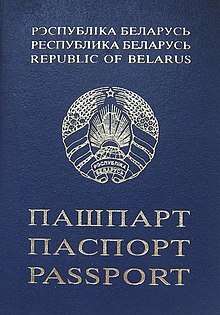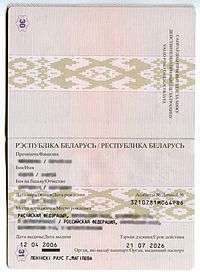Belarusian passport
A Belarusian passport is issued to citizens of Belarus and is used for both external and internal travel. Unlike Russia and Ukraine, there are no internal passports in Belarus. Passports are issued by the Ministry of Internal Affairs in Belarus and by the Ministry of Foreign Affairs to citizens who live abroad.
| Belarusian passport | |
|---|---|
 Belarusian passport cover | |
| Type | Passport |
| Issued by | |
| First issued | 15 May 2006 (current version) |
| Purpose | Identification |
| Eligibility | Belarusian citizenship |
| Expiration | 10 years |
"AB" series passports are assigned to Brest Voblast, "BM" series passports - Vitsebsk Voblast, "HB" series passports - Homel Voblast, "KH" series passports - Hrodna Voblast, "MP" series passports - Minsk city, "MC" series passports - Minsk Voblast, "KB" series passports - Mahilyow Voblast, "PP" series passports are assigned to the Ministry of Foreign Affairs.
Passports can be issued to citizens at any age. Upon turning 14, every citizen is encouraged to obtain a passport. Belarusian passports have blue covers.
Article 14 of the "Treaty on the Union between Belarus and Russia" expects the future introduction of identity documents of the Russo-Belarusian union.




History
Until Belarus established its independence, Soviet passports were used. In spite of the fact that Byelorussian SSR citizenship (like citizenship of all other soviet republics) was recognised by the USSR, Soviet passports never mentioned Byelorussian SSR citizenship. Soviet passports issued by the Ministry of Internal Affairs in the Byelorussian SSR (as well as birth certificates) had records in both Belarusian and Russian.
 1918
1918.jpg) 1991-1995
1991-1995 1991-1995
1991-1995
Information
A Belarusian passport contains the following information, printed in Belarusian, Russian and English:
- Given name, surname and patronymic name (the latter only in Belarusian and Russian)
- Date of birth
- Identification number
- Sex
- Place of birth
- Date of issue
- Date of expiry
- Authority
- Holder's signature
- Signature of the authority issuing the Passport
- Official seal
- Place of residence
- Visas (optional)
- Consular stamps (for those who live abroad)
- Information about children under 16 (if any)
- Information regarding marital status and the spouse's details (if any)
- Blood group and Rhesus factor (optional)
- Ethnic origin (optional)
Moving abroad permission stamps
Until 1 January 2008, Belarusian citizens had to apply for permission stamps in their passports in order to cross Belarusian borders. Permission stamps were given if there were no specific legal restrictions for their moving abroad.
In 2002, Constitutional Court of Belarus stated in its decision that permission stamps were not constitutional. The Council of Ministers was ordered to propose a different kind of a citizen border control by 31 December 2005.
By a Presidential decree issued on 17 December 2007, permission stamps were finally abolished.
Visa requirements

As of October 2018, Belarusian citizens had visa-free or visa on arrival access to 77 countries and territories, ranking the Belarusian passport 68th in terms of travel freedom according to the Henley Passport Index.[1]
External links
| Wikimedia Commons has media related to Passports of Belarus. |
References
- "Global Ranking - Passport Index 2018" (PDF). Henley & Partners. Retrieved 25 November 2018.
.svg.png)